MSI GT627: Bringing Balance to the Force?
by Jarred Walton on April 29, 2009 4:00 AM EST- Posted in
- Laptops
Balanced Gaming Performance
We've chosen to focus on "reasonable" settings for the games below. That means we run Assassin's Creed and Company of Heroes in DX9 mode at maximum detail setting - DX10 reduces performance by quite a bit in AC and by a much larger amount in CoH. We run Crysis at Medium settings (for reference, High detail drops performance almost in half: 18.75 FPS for the GT627 at 1680x1050). The remaining games are at maximum detail settings, but without any anti-aliasing. It's also important to remember that driver updates have improved performance in quite a few games, so results from the Alienware m15x, Gateway P-171XL, P-6831, and P-7811 would improve in many games if we used the latest driver.
Again, we chose to focus on 1680x1050 as a baseline performance comparison. We use an external LCD to run at that resolution when necessary, as in the case with the GT627. If you don't care about comparative performance, focus on the performance at the native resolution of 1280x800, shown in red. Overclocking results at 1280x800 are shown in orange, 1680x1050 will be green, and 1080p is in gold.
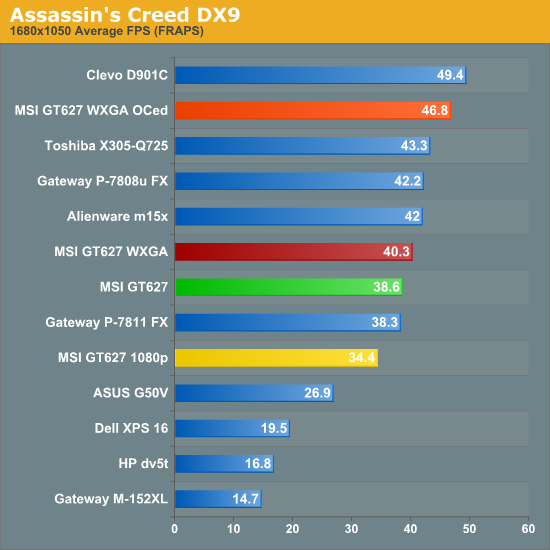
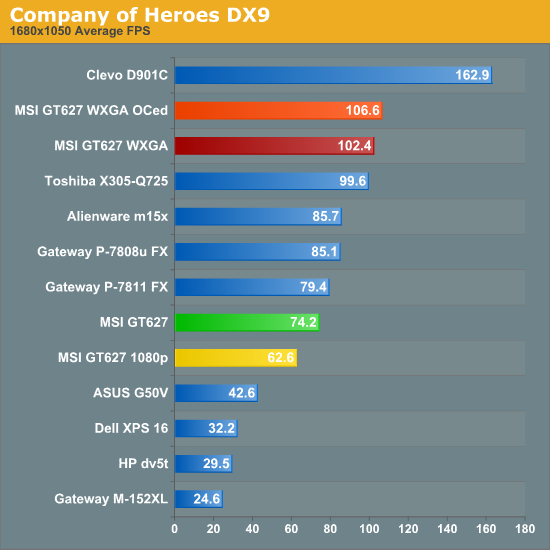
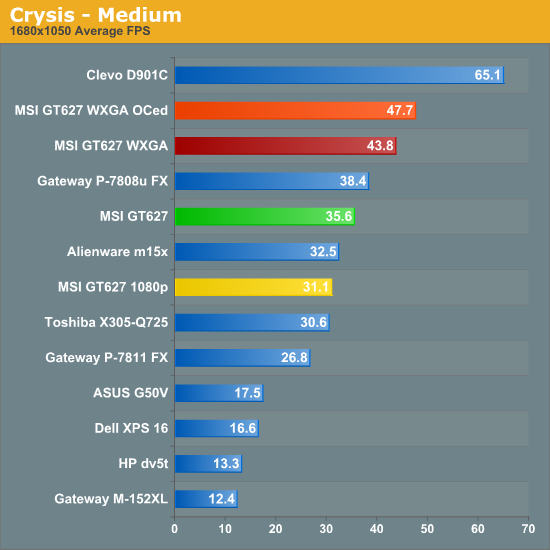
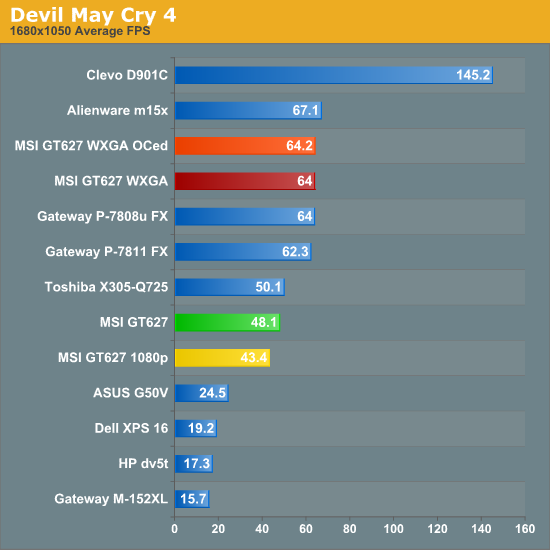
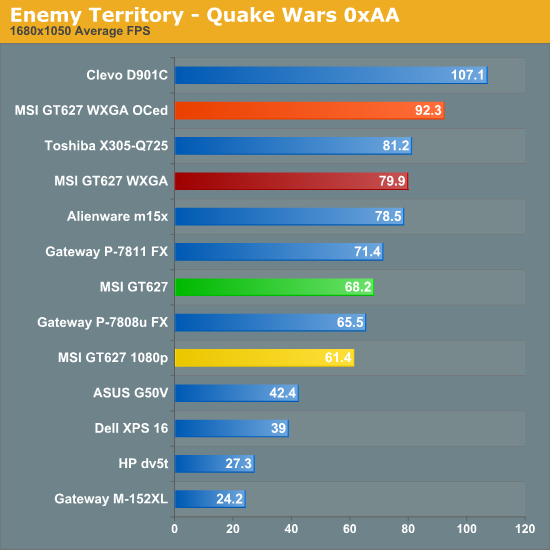

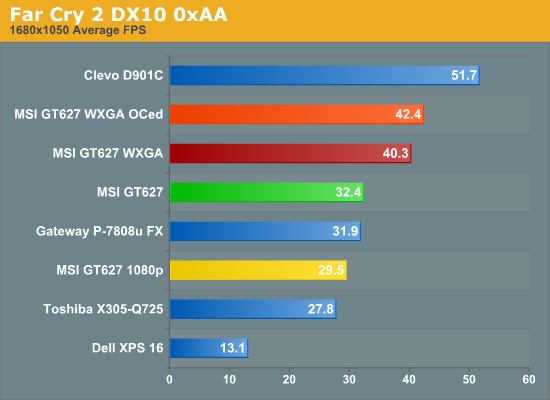
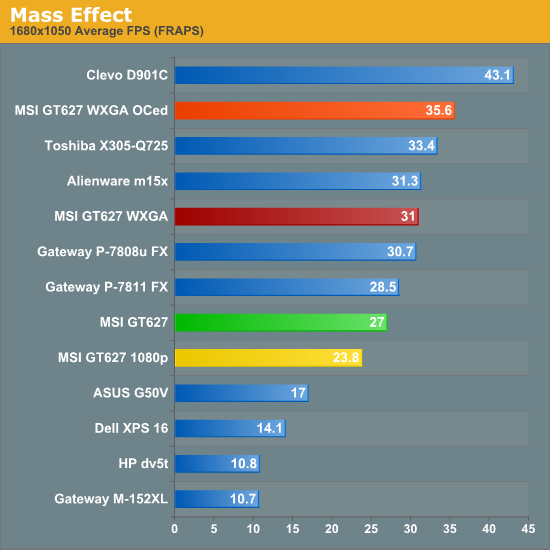
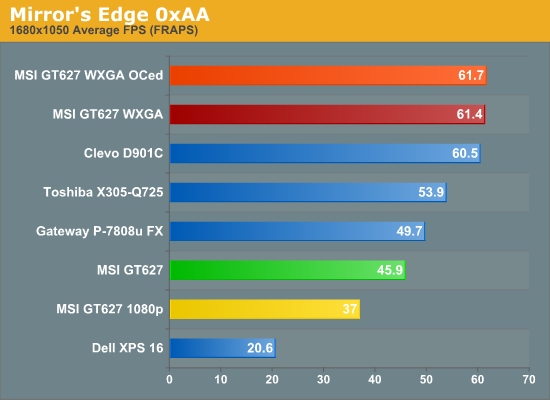
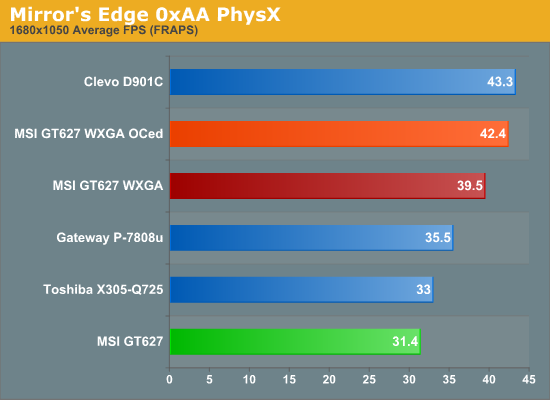
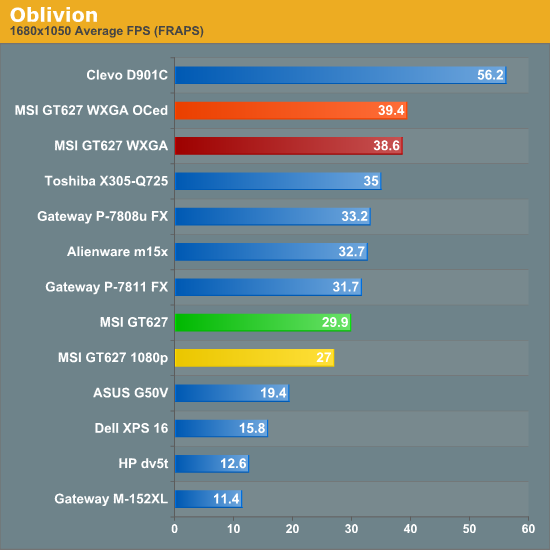
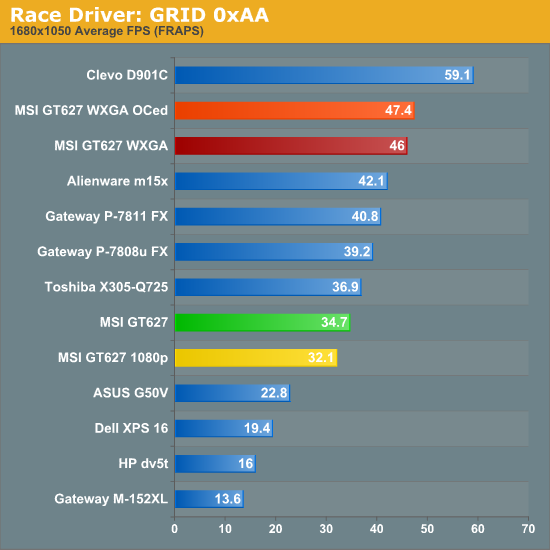
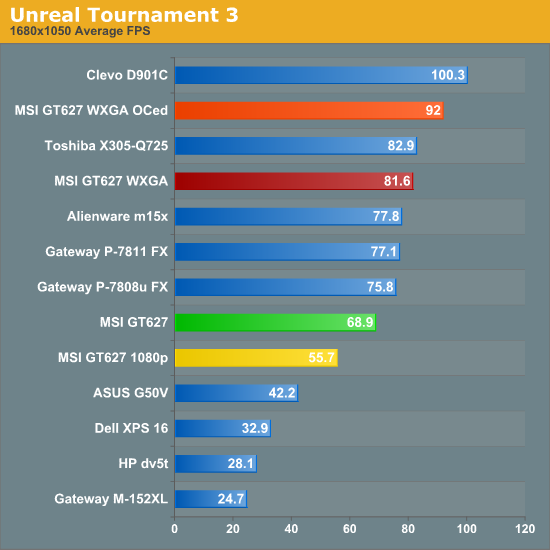
Here is where the "balanced" approach to gaming notebooks clearly pays off. Despite having a "slower" dual-core processor and a slightly slower 9800M GS graphics chip, the MSI GT627 is very competitive with the Gateway P-7808u. It's on average 10% slower in the tested games, and in a few cases it's actually faster because of the higher CPU clock speed. There are a few games where the quad-core CPU in the P-7808u definitely helps, i.e. Devil May Cry 4, but those tend to be the exception rather than the rule. If we look at just the GPU difference, the Gateway's 9800M GTS has core and shader clock speeds that are 13% higher than the MSI's 9800M GS, while memory bandwidth remains the same. Many games are going to be limited by GPU core/shader performance, so the 10% average improvement is exactly what we would expect if the CPU isn't a bottleneck.
While the GT627 may not be the fastest gaming notebook in terms of raw power, we again need to consider performance at the native resolution. 1280x800 performance doesn't tax the GPU nearly as much of 1680x1050, so the combination of the GeForce 9800M GS, Core 2 Duo P8400, and WXGA LCD works out very well. In fact, looking at the overclocked results, we can see that many games are CPU limited at the native resolution, which makes the overclocking feature a nice extra. The only game we test where performance isn't acceptable at 1280x800 is Crysis at high quality defaults, but even that still looks and runs fine at medium detail.
We would be remiss, however, if we didn't point out the fact that even the best gaming notebooks are still a generation (or more) behind current desktop offerings. The 9800M GS used in the MSI is essentially the same as the 9600 GT desktop card. In fact, it's a bit slower, since core/shader/GPU speeds on the desktop part are still higher. Put another way, if you don't need mobility you can build a complete budget system, add a reasonable video card like the Radeon HD 4770 - or even the GeForce GTX 275 - and still end up with a price several hundred dollars cheaper than this midrange gaming notebook. The only reason to purchase a gaming notebook is if you need/want mobility... or if you just have a lot of money to spend. Otherwise, the gaming experience will be far better on even a basic desktop system.










47 Comments
View All Comments
B3an - Wednesday, April 29, 2009 - link
I'm not buying a new laptop until i can get one with a decent display. I agree with this review about the poor displays in most of them. I've been waiting 2 years so far to upgrade to something like a LED backlit laptop with a good screen res and image quality, or just one with a good IPS and normal backlighting even. But they're taking there time!!Hrel - Wednesday, April 29, 2009 - link
The review laptop needs to be $900 or less, simply look at this one: http://www.bestbuy.com/site/olspage.jsp?skuId=9050...">http://www.bestbuy.com/site/olspage.jsp...&typ...The MSI Model with the faster CPU and higher resolution screen should be about $1100.
Finally, crappy keyboard and cracking chassis' WHILE IN A BAG is just completely unacceptable. I think right now the Asus is still the way to go; though I really would like to see a higher resolution screen. 1520x855 or 1600x900 like Sony offers would be GREAT!!!
Hrel - Wednesday, April 29, 2009 - link
That's amazing, the MSI is at the top of the list every single time; it even manages to beat out the Clevo at least once; then it's second the other times. Simply awesome! Can't believe that small overclock makes that big of a difference.Hrel - Wednesday, April 29, 2009 - link
I'm referring to the gaming test in the above comment; just to be clear.Mikey - Wednesday, April 29, 2009 - link
I think this is a great review for a great notebook. Never is there anything that is ever perfect when it comes to new tech in the market, but this MSI notebook can do it all. I don't know why these companies don't have the brains to use common sense and fix these little "issues" that people have with it. Don't they know that they could make a better product using better material? So what if it costs $100 more. I think that is worth the improvements that most people within this market segment is looking for.http://www.dumpsternationwide.com/">roll off dumpsters and containers>
crimson117 - Wednesday, April 29, 2009 - link
How do you think the screen will be on this one? 17", 1680x1050, and claims to include "MSI vivid image enhancement technology"http://www.msimobile.com/level3_productpage.aspx?c...">http://www.msimobile.com/level3_productpage.aspx?c...
JarredWalton - Wednesday, April 29, 2009 - link
Well, I can't say without testing in person, but take http://www.samsung.com/global/business/lcdpanel/pr...">Samsung's current laptop LCDs as a starting point. Their 17" option with WSXGA+ resolution lists a 45% color gamut (blech!), 300 nit brightness, and no contrast ration. There's a good chance that it will be a 500:1 contrast or higher, but no guarantee. If you walk down the aisles at Best Buy, Office Depot, or a similar store and look at the displays, you will likely notice that around 60-75% have poor contrast ratios, and all of them are TN panels.crimson117 - Wednesday, April 29, 2009 - link
I guess what I really want is a Dell Studio XPS 16 with a better graphics card (such as a AMD Mobile 4850).IlllI - Wednesday, April 29, 2009 - link
i'd be careful with dell. they've been known in the past to do 'panel lottery' so you might not get the same kind of lcd panel that they have in it nowJarredWalton - Wednesday, April 29, 2009 - link
I'm pretty sure if you get one of the Dell laptops with a high color gamut RGB LED backlit LCD, the panels will all come from the same source (i.e. no lottery). I only know of one manufacturer doing RGB LEDs right now, at least (Seiko Epson).